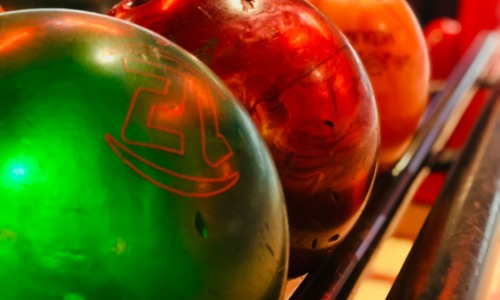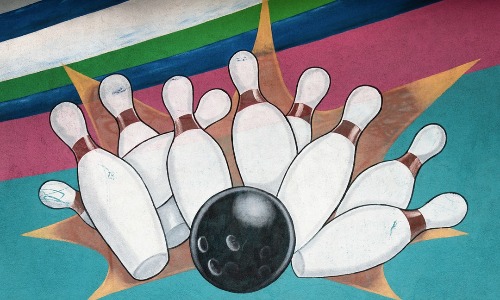The Two-hand Layout System (2LS) is a modern drilling method specifically designed for two-handed and thumbless bowlers. Unlike traditional layout systems based on angles (such as the Pin-to-PAP, VAL angle, and PSA angle), 2LS defines the layout using three distance-based measurements. This makes it highly suitable for players whose axis point (PAP) is difficult to define consistently—like most two-handers.
This article explains how 2LS works, how to mark the ball properly, and how layout differences affect ball motion and line choices.
🔍 What is 2LS?
2LS is a layout system that replaces angular measurements with three distances to describe the placement of the core and mass bias in relation to the bowler’s release. It simplifies layout construction and is more accurate for two-handers who may not have a stable PAP.
✅ The 3 measurements used in 2LS:
- Pin-to-PAP Distance — controls the core’s tilt and how early the ball transitions
- PSA-to-PAP Distance — controls the direction and sharpness of backend motion
- Pin-to-Grip Center Distance — affects the ball’s differential (ΔRG) and overall flare potential
All values are given in inches.
✏️ Why use 2LS?
For two-handed bowlers, traditional layouts can be unstable because:
- The PAP (Positive Axis Point) is often lower and more dynamic
- There is no thumb to stabilize axis rotation
- High rev rates and axis tilt vary more from player to player
Using distance instead of angle allows for precise control of how and when the ball transitions.
📐 How to Apply a 2LS Layout
Step 1: Determine the Grip Center (GC)
- Use the midpoint between the two finger holes
- This remains valid even in thumbless setups
Step 2: Determine or estimate your PAP
- Most two-handers fall within 4 3/8″ to 4 5/8″ horizontal, and 0″ to +1″ vertical
- If the release is late or early, the numbers can be way off.
- If you can’t measure PAP directly, use a standard estimate based on rev rate and track location
Step 3: Draw reference lines
Before marking, it’s important to understand how the Pin-to-Grip Center (Pin-to-GC) distance affects the ball’s differential (ΔRG). The baseline distance is 3 3/8 inches:
- Shorter than 3 3/8″ → ΔRG decreases → lower flare potential, smoother motion, earlier hook
- Longer than 3 3/8″ → ΔRG increases → higher flare potential, sharper backend, delayed hook
This allows you to manipulate the strength and shape of the motion depending on the condition you’re preparing for.
- Mark the Grip Center (GC)
- Locate your PAP from GC using the estimated PAP values
- Measure from the Pin to PAP (e.g., 5″) and mark that arc
- Measure from PSA to PAP (e.g., 4 1/4″) and mark it
- Ensure the Pin is at the desired distance from GC (e.g., 3 3/4″) — adjust as needed
Using a protractor or layout tool can help maintain precision.
🧪 Layout Examples and Their Line Characteristics
| Layout (2LS) | Ball Motion | Line Strategy |
|---|---|---|
| 5″ × 5″ × 3 3/4″ | Long skid, sharp backend | Play outside-in with angle; strong recovery from dry boards |
| 4 3/4″ × 4″ × 4 1/2″ | Earlier roll, smooth arc | Use inside-out arc lines; good for fresh and medium oil |
| 5 1/4″ × 4 1/2″ × 4″ | Delayed hook, aggressive backend | Ideal for wide angles and long oil conditions |
| 4 1/2″ × 3 3/4″ × 2 1/2″ | Early read, smooth motion | Best for dry lanes or tight line control |
📊 How the Three Distances Affect Ball Motion
| Parameter | Shorter Distance | Longer Distance |
| Pin-to-PAP | Earlier hook, faster roll phase | Delayed hook, longer skid |
| PSA-to-PAP | Quicker transition, sharper motion | Smoother motion, backend control |
| Pin-to-GC | Low differential (less flare), smoother | High differential (more flare), sharper change |
🧠 Tips Based on Style
- High rev / Medium speed: Longer Pin-to-PAP (~5″), mid PSA (~4.25″), shorter Pin-to-GC (~3.5″) for balance
- Low rev / High speed: Shorter Pin-to-PAP (~4.5″), longer PSA (~4.5″), longer Pin-to-GC (~3.75″–4″) for stronger motion
✅ Conclusion
2LS offers a practical, distance-based layout system tailored to the unique style of two-handed bowlers. It simplifies layout selection, improves predictability, and gives bowlers the ability to fine-tune motion through measurable distances.
If you’re struggling with inconsistent ball reaction or feel like your layouts aren’t matching your game, try switching to the 2LS method. It may unlock a whole new level of consistency and control.



コメント